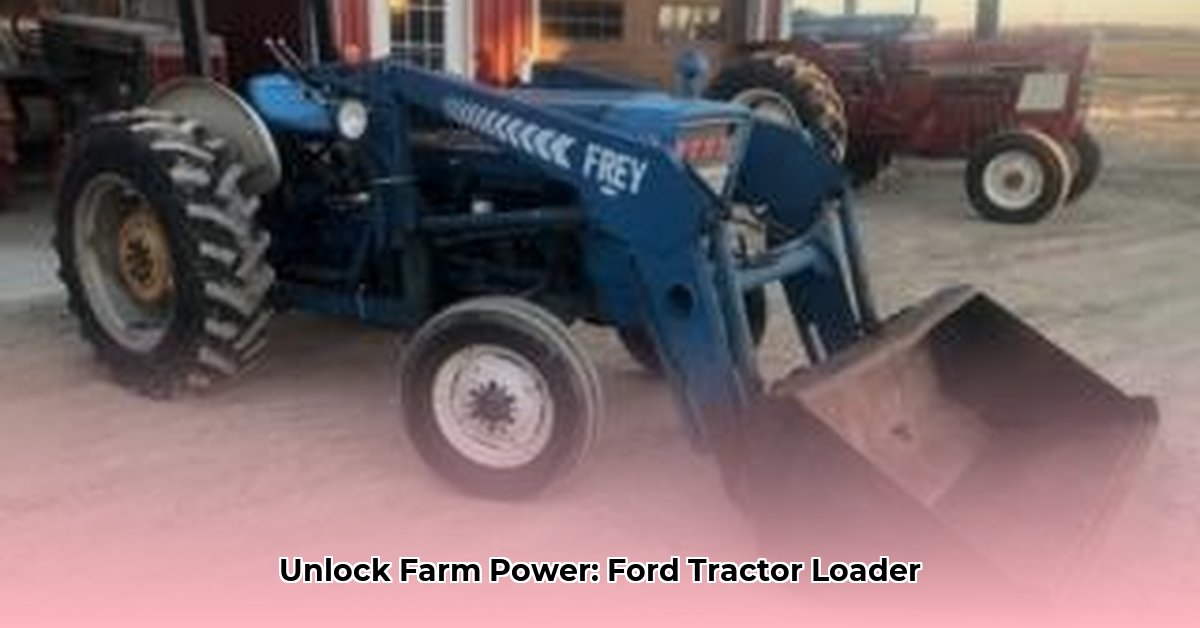
Choosing the right Ford tractor with a loader can significantly improve your farm's efficiency and sustainability. This guide helps you select, operate, maintain, and utilize a Ford tractor and loader for optimal results, focusing on environmentally conscious practices. For more information on small tractors with loaders, check out this helpful resource: Small Tractor Guide.
Picking the Perfect Ford Tractor and Loader Combo
The ideal Ford tractor and loader combination depends on your farm's size, tasks, and budget. For larger farms, a powerful tractor with high lift capacity is necessary. Smaller operations benefit from more compact models. Careful consideration of future needs is vital; sometimes, investing in a slightly larger tractor proves cost-effective in the long run. Don't underestimate the potential growth of your farm!
| Model | Engine Horsepower | Lifting Capacity (lbs) | Best Uses | Fuel Efficiency (gallons/hour) | Notes |
|---|---|---|---|---|---|
| Ford 4610 | 45 | 2,500 | Lighter tasks (tilling, material handling, manure management) | Variable, depends on the job | Suitable for smaller farms or specific tasks |
| Ford 5000 | 55 | 3,500 | Heavier tilling, pallet handling, animal feeding | Variable, depends on the job | Increased power for more demanding tasks |
| Ford 8700 | 85 | 5,000 | Large-scale operations, heavy lifting | Variable, depends on the job | Ideal for large farms requiring substantial power |
Remember to thoroughly review specifications and consider long-term needs. Consult your local Ford dealership for the most up-to-date information and personalized recommendations.
Operating Your Tractor and Loader Safely and Efficiently
Safe and efficient operation is paramount. Follow these numbered steps:
Pre-Operation Inspection: Before starting, thoroughly inspect the tractor and loader for damage, loose parts, and fluid levels (oil, coolant, hydraulic fluid). Addressing small issues prevents larger problems down the line.
Secure Attachment: Ensure the loader is securely attached and locked. Proper positioning provides optimal visibility of the work area, enhancing safety and efficiency.
Load Management: Avoid overloading the loader. Evenly distribute heavy loads to prevent damage and maintain stability. Overloading is dangerous and can severely damage your equipment. Think of it like balancing a seesaw; you want even weight distribution. This significantly reduces strain on the loader and improves safety.
Controlled Movements: Raise and lower the loader smoothly and slowly. Avoid jerky movements which risk damage and accidents. This also contributes to fuel efficiency.
Safe Transportation: When transporting materials, maintain a steady, slow speed. Constantly observe your surroundings for obstacles, people, or animals.
Post-Operation Check: Before turning off the engine, lower the loader completely. Perform a final inspection of the tractor and loader.
These steps minimize safety risks and ensure optimal operational efficiency.
Keeping Your Tractor in Tip-Top Shape
Regular maintenance is vital for extending the tractor's lifespan and minimizing environmental impact. Proactive maintenance translates to cost savings in the long run.
Adherence to Schedule: Follow the manufacturer's recommended service schedule, including oil changes, filter replacements, and tire pressure checks. This preventative maintenance is crucial for overall operational efficiency.
Prompt Attention to Minor Issues: Addressing minor problems immediately prevents them from escalating into costly repairs. Early detection saves time and money.
Responsible Disposal: Dispose of used oil and filters responsibly through local recycling programs. Repurposing usable parts reduces waste and promotes sustainability. This is a critical aspect of environmental stewardship.
Proper maintenance isn't just about mechanical integrity; it contributes significantly to sustainable farming practices.
Using Your Ford Tractor and Loader for Sustainable Farming
A Ford tractor with a loader significantly enhances sustainable agricultural practices:
Precision Fertilizer Application: Careful handling and distribution of fertilizers minimizes waste and optimizes nutrient delivery to crops. This improves yields while reducing environmental impact. Doesn't this sound like a win-win situation?
Reduced Soil Compaction: Proper techniques prevent soil compaction, preserving soil health and water absorption, which are crucial for long-term sustainability. Imagine the long-term productivity benefits!
Efficient Manure Management: Simplified manure handling enables efficient composting or biogas production, reducing reliance on synthetic fertilizers and promoting a circular economy within your farm. How does this improve your farm's overall sustainability?
Water Conservation (Indirect): While not directly related to the loader's function, efficient manure management with the loader indirectly conserves water by improving soil structure which helps absorb water more efficiently. Did you know that efficient water use is a crucial element of sustainable agriculture?
These practices improve both environmental sustainability and farm profitability.
Key Takeaways: Boosting Efficiency and Sustainability
A Ford tractor with a loader dramatically improves efficiency and sustainability on farms of all sizes. Are you ready to experience these benefits firsthand?
Careful tractor selection aligns with your farm's unique needs and budget constraints. Have you carefully considered your specific farm needs?
Prioritizing safe and efficient operation minimizes fuel consumption and environmental impact. What steps will you take to improve your operational efficiency?
Regular maintenance is essential for maximizing tractor longevity and performance. Do you have a comprehensive maintenance schedule in place?
The tractor directly supports sustainable farming practices by improving resource management and profitability – a testament to its impact on long-term farm success.
This guide provides a framework for maximizing the benefits of a Ford tractor with a loader while contributing to sustainable agricultural practices. Remember to consult your owner's manual for detailed operating instructions and maintenance schedules specific to your model.